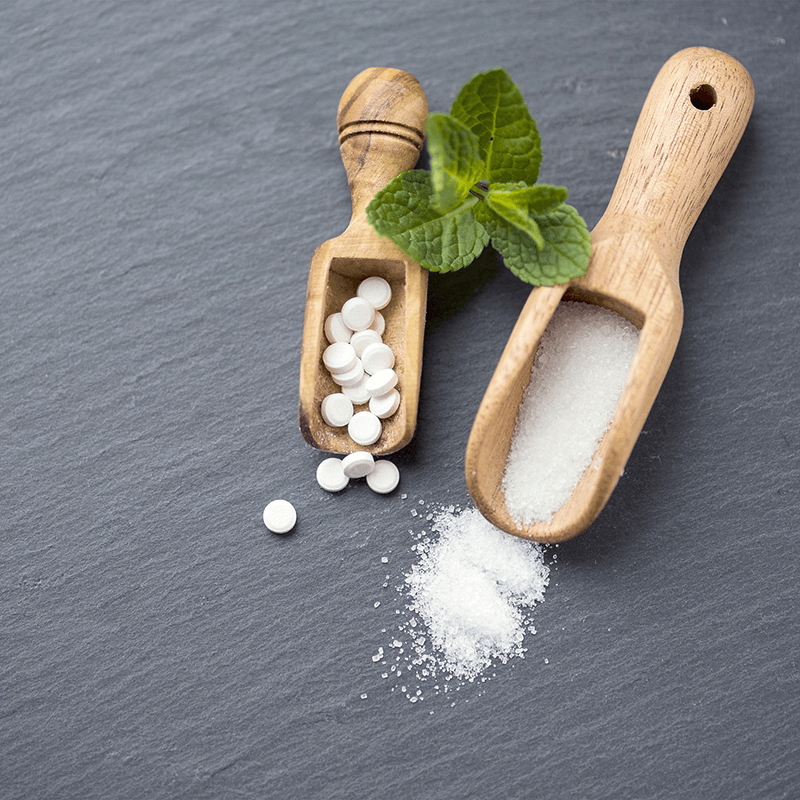I. Introduction
Natural sweeteners are substances derived from natural sources such as plants or fruits that are used to sweeten foods and beverages. They are often considered healthier alternatives to refined sugars and artificial sweeteners due to their natural origins and potential health benefits.
In recent years, there has been a significant shift in consumer preferences towards natural sweeteners. With an increasing emphasis on health and wellness, people are seeking out alternatives to traditional sugars and artificial sweeteners. This growing trend is driven by a desire for clean label products and a greater awareness of the potential health risks associated with excessive consumption of refined sugars and synthetic sweeteners.
This comprehensive guide will delve into various natural sweeteners that are gaining popularity in the market. It will explore their origins, sweetness levels, unique characteristics, and applications in different industries. Additionally, it will discuss the advantages of choosing natural sweeteners, their diverse applications, and the promising future of the natural sweetener industry.
II. Some Main Natrual Sweeteners
Sugar Alcohols (Xylitol, Erythritol, and Maltitol)
A. Origins and sources of each sweetener
Xylitol Xylitol is a sugar alcohol that occurs naturally in many fruits and vegetables. It is also produced from the birch tree and other hardwoods. Xylitol is often used as a sugar substitute in sugar-free gum, mints, and toothpaste due to its dental benefits.
Erythritol Erythritol is a sugar alcohol that is found naturally in some fruits and fermented foods. It can also be commercially produced by fermenting glucose with yeast. Erythritol is commonly used as a low-calorie sweetener in sugar-free products and beverages.
Maltitol Maltitol is a sugar alcohol produced from maltose, which is derived from starches such as corn or wheat. It is often used as a sugar substitute in sugar-free candies, chocolates, and baked goods due to its ability to mimic the sweetness and texture of sugar.
B. Sweetness level compared to regular sugar
Xylitol is approximately as sweet as regular sugar, with about 60-100% of the sweetness of sucrose.
Erythritol is about 60-80% as sweet as sugar.
Maltitol is similar in sweetness to regular sugar, with about 75-90% of the sweetness of sucrose.
C. Key characteristics and benefits
All three sugar alcohols are lower in calories than sugar, making them popular choices for individuals looking to reduce their calorie intake or manage their blood sugar levels.
Xylitol has been shown to have dental benefits, as it helps prevent tooth decay and is often used in oral care products.
Erythritol is well-tolerated by most people and does not cause a significant increase in blood sugar or insulin levels, making it suitable for individuals with diabetes.
Maltitol is known for its ability to replicate the taste and texture of sugar in various food products, making it a popular ingredient in sugar-free confections and baked goods.
Monk Fruit Extract (Mogroside)
A. Source and cultivation of monk fruit
Monk fruit, also known as Luo Han Guo, is a small, round fruit native to southern China. It has been used in traditional Chinese medicine for centuries due to its sweet flavor and potential health benefits. The fruit is grown on vines in the lush mountainous regions of China, where it thrives in a subtropical climate with well-drained soil and sufficient sunlight. The cultivation of monk fruit involves careful attention to environmental conditions and specialized horticultural techniques to ensure a high-quality harvest.
B. Intensity of sweetness and taste profile
Monk fruit extract, also known as mogroside, is a natural sweetener that is remarkably sweet, with an intensity far greater than that of traditional sugar. The sweetness of monk fruit extract is derived from its naturally occurring compounds called mogrosides, which are several hundred times sweeter than sugar on a per-gram basis. However, despite its intense sweetness, monk fruit extract has a unique taste profile characterized by a pleasant, fruity flavor without the bitter aftertaste often associated with other non-nutritive sweeteners. This makes it a desirable natural sweetening option for individuals seeking to reduce their sugar intake without sacrificing taste.
C. Notable features and health advantages
Zero-calorie and low-glycemic index:
Monk fruit extract is naturally free from calories and has a minimal impact on blood sugar levels, making it an ideal sweetener for individuals monitoring their caloric intake or managing diabetes.
Antioxidant properties:
Monk fruit extract contains compounds with antioxidant properties, which may contribute to its potential health benefits, such as reducing oxidative stress and inflammation in the body.
Suitable for natural and clean-label products:
As a naturally derived sweetener, monk fruit extract aligns with the growing consumer demand for clean-label, minimally processed ingredients, making it a popular choice for manufacturers seeking natural alternatives to artificial sweeteners.
Tooth-friendly: Unlike sugar, monk fruit extract does not promote tooth decay, making it a favorable option for oral care products and sugar-free confections.
Stevioside (Stevia Extract)
Stevioside, a naturally occurring glycoside compound found in the leaves of the Stevia rebaudiana plant, has gained significant attention as an alternative sweetener in recent years. Its rising popularity is attributed to its zero-calorie content, significantly higher sweetness compared to sugar, and potential health benefits.
A. Origin and extraction process of stevioside
Stevia plants, native to South America and parts of North America, have been used for centuries by indigenous populations as a sweetening agent and for medicinal purposes. The extraction process of stevioside involves harvesting the leaves of the Stevia rebaudiana plant and isolating the glycoside compounds, particularly stevioside and rebaudioside, through a series of purification and filtration steps. The extraction can be achieved through water extraction or ethanol extraction methods, depending on the desired purity of the final product. The resulting stevia extract, often in the form of a white or off-white powder, is then used as a natural sweetener in various applications.
B. Relative sweetness compared to sugar
Stevioside is known for its remarkable sweetness, with a potency significantly higher than that of traditional sugar. On a weight-to-weight basis, stevioside is estimated to be approximately 200 to 300 times sweeter than sucrose (table sugar), making it an attractive alternative for individuals seeking to reduce their sugar intake while maintaining the desired level of sweetness in their food and beverages.
C. Unique properties and health benefits
Stevioside possesses several unique properties and potential health benefits, which contribute to its appeal as a natural sweetener:
Zero-calorie and low-glycemic index: Stevioside is devoid of calories and has a negligible impact on blood glucose levels, making it a suitable option for individuals aiming to manage their weight or blood sugar levels.
Non-cariogenic and tooth-friendly: Unlike sugar, stevioside does not promote tooth decay, making it a favorable choice for oral care products and sugar-free confections.
Potential for supporting metabolic health:
Some studies suggest that stevioside may have insulin-sensitizing and anti-hyperglycemic effects, which could be beneficial for individuals with metabolic conditions such as diabetes or insulin resistance.
Antioxidant properties: Stevioside contains compounds with antioxidant activity, which may contribute to its potential health-promoting effects, such as reducing oxidative stress and inflammation.
Neohesperidin Dihydrochalcone (NHDC)
A. Natural sources and manufacturing of NHDC Neohesperidin dihydrochalcone (NHDC) is a natural sweetener derived from bitter orange (Citrus aurantium) and other citrus fruits. NHDC is extracted from the peel or whole fruits of these citrus sources through a multi-step manufacturing process. The extraction typically involves isolating neohesperidin from the fruits, chemically modifying it through hydrogenation, and then forming the dihydrochalcone through the process of hydrogenation. The final product is a white to off-white crystalline powder with a sweet taste. NHDC production is often carried out to enhance the natural sweetness of citrus fruits, and offer an alternative to artificial sweeteners.
B. Relative sweetness levels in comparison to sugar
NHDC is known for its intense sweetness, with a relative sweetness level estimated to be approximately 1500 to 1800 times sweeter than sucrose (table sugar) on a weight-to-weight basis. This high potency allows for its use in minuscule amounts to achieve the desired level of sweetness in food and beverages, thereby reducing the overall caloric content.
C. Distinctive characteristics and uses
The unique characteristics of NHDC make it a sought-after natural sweetener with various applications and uses:
Heat stability: NHDC displays exceptional stability under high temperatures, making it suitable for use in baked goods, confections, and other food products that undergo heat processing without losing their sweetness.
Synergistic effects: NHDC has been found to enhance the sweetness and flavor profile of other sweetening agents and natural flavors, allowing for the creation of well-rounded and palatable formulations in food and beverage products.
Masking bitterness: NHDC can mask bitter taste perceptions, rendering it valuable in reducing the bitterness in pharmaceuticals, nutraceuticals, and functional beverages.
Non-cariogenic: NHDC does not contribute to tooth decay, making it a favorable option for formulating oral care products and sugar-free confections.
Applications in dietary supplements: NHDC can be utilized in the production of dietary supplements, contributing to the enhanced palatability of supplement formulations without the addition of excess calories or sugars.
Beet Root Extract
A. Cultivation and extraction process of beet root extract
Beets, scientifically known as Beta vulgaris, are root vegetables that are cultivated in various regions around the world. The cultivation of beets involves planting seeds in well-drained soil with adequate moisture and sunlight. The growing season typically ranges from 8 to 10 weeks, after which the beets are harvested. Once harvested, the roots undergo a meticulous extraction process to obtain beet root extract.
The extraction process involves washing the beets to remove soil and debris, followed by cutting them into smaller pieces to increase the surface area for extraction. The chopped beets are then subjected to extraction methods such as pressing, grinding, or heating to release the natural juices and bioactive compounds present in the beets. After extraction, the liquid is further processed to concentrate and isolate the valuable components through methods such as filtration, clarification, and evaporation, ultimately yielding the beet root extract in its desired form.
B. Levels of sweetness and flavor profile
Beet root extract possesses a natural sweetness attributed to its sugar content, primarily consisting of sucrose, glucose, and fructose. The sweetness levels of beet root extract are notable, but not as intense as some other natural sweeteners, such as stevia or monk fruit extract. The flavor profile of beet root extract is characterized by earthy, slightly sweet notes with subtle undertones reminiscent of the vegetable itself. This distinct flavor profile lends itself well to a variety of culinary and beverage applications, contributing a unique and natural taste experience to products.
C. Notable attributes and health benefits
Beet root extract is recognized for its noteworthy attributes and associated health benefits, which include:
Nutritional value: Beet root extract contains essential nutrients such as vitamins, minerals, and dietary fibers, contributing to its nutritional profile. It is a good source of folate, manganese, potassium, and vitamin C, making it a valuable ingredient for fortifying food and beverage products.
Antioxidant properties: The extract is rich in natural antioxidants, particularly betalains and polyphenols, which exhibit strong antioxidant activity. These compounds have been linked to potential health benefits, including supporting cellular health, combating oxidative stress, and promoting overall well-being.
Support for cardiovascular health: Consumption of beet root extract has been associated with potential cardiovascular benefits, including blood pressure regulation, improved endothelial function, and enhanced exercise performance due to its nitrate content, which can be converted to nitric oxide in the body.
Anti-inflammatory properties: The bioactive compounds in beet root extract have been studied for their anti-inflammatory effects, showing promise in modulating inflammatory pathways and promoting overall health and wellness.
III.Why Choose Natural Sweeteners
A. Advantages of natural sweeteners over artificial alternatives
Natural sweeteners offer several advantages over artificial alternatives, including:
Health benefits: Natural sweeteners are often lower in calories and have a lower glycemic index compared to artificial sweeteners, making them a preferred choice for individuals looking to manage their weight or blood sugar levels. Additionally, some natural sweeteners, such as honey and maple syrup, contain beneficial nutrients and antioxidants that contribute to overall health.
Clean taste: Natural sweeteners are known for their clean and pure taste, free from any artificial aftertaste or chemical undertones that are commonly associated with artificial sweeteners. This enhances the overall sensory experience of food and beverages sweetened with natural alternatives.
Source of natural energy: Many natural sweeteners, such as coconut sugar and agave nectar, provide a source of natural energy due to their carbohydrate content. This can be particularly appealing for individuals seeking a natural, sustained energy source as opposed to the quick spike and subsequent crash associated with refined sugars and artificial sweeteners.
Digestibility: Natural sweeteners are often easier to digest for some individuals, as they are less processed and closer to their original form in comparison to artificial sweeteners. This can make them a gentler option for those with digestive sensitivities or intolerances.
B. Health and wellness considerations
The choice of natural sweeteners has significant implications for health and wellness. Natural sweeteners offer the following considerations in support of overall well-being:
Nutritional value: Many natural sweeteners contain beneficial nutrients and bioactive compounds that are absent in artificial sweeteners. For example, raw honey contains enzymes and trace amounts of vitamins and minerals, while maple syrup provides minerals such as manganese and zinc. This nutritional value can contribute to a more balanced diet when natural sweeteners are used in moderation.
Blood sugar management: Certain natural sweeteners, such as stevia and monk fruit extract, do not significantly impact blood sugar levels, making them suitable options for individuals with diabetes or those aiming to minimize fluctuations in blood glucose.
Antioxidant properties: Some natural sweeteners, including molasses and blackstrap molasses, are rich in antioxidants that help combat oxidative stress and support cellular health. These properties can contribute to a more holistic approach to well-being when natural sweeteners are incorporated into the diet.
Reduced chemical exposure: Using natural sweeteners can reduce exposure to artificial additives and chemical sweetening agents that are prevalent in many artificial sweeteners. This aligns with the overarching goal of minimizing synthetic substances in one's diet for long-term health benefits.
C. Environmental and sustainability factors
The production and utilization of natural sweeteners present environmental and sustainability advantages when compared to artificial sweeteners:
Plant-based sourcing: Natural sweeteners are predominantly derived from plant sources, such as fruits, herbs, and trees. The cultivation and harvesting of these natural sources can be more environmentally friendly compared to the energy-intensive processes involved in producing artificial sweeteners through chemical synthesis.
Biodiversity conservation: Many natural sweeteners, such as agave nectar and stevia, are derived from plants that can be grown sustainably, contributing to biodiversity and ecological balance. This contrasts with the monoculture and potential environmental impacts associated with the large-scale production of certain artificial sweeteners.
Reduced chemical runoff: The cultivation of natural sweetener sources, when managed using sustainable farming practices, can contribute to reduced chemical runoff and soil pollution, mitigating the environmental impact on waterways and ecosystems.
Biodegradability: Natural sweeteners are often biodegradable and compostable, offering a more eco-friendly option compared to persistent synthetic compounds used in artificial sweeteners.
D. Consumer demand for clean label products
The trend towards clean label products, characterized by transparency, minimal processing, and natural ingredients, has driven the preference for natural sweeteners among consumers:
Ingredient transparency: Consumers are increasingly seeking products with transparent labeling and recognizable ingredients. Natural sweeteners align with this demand by offering familiar, minimally processed options that resonate with consumer preferences for clean, straightforward formulations.
Avoidance of artificial additives: The growing awareness of the potential health implications of artificial additives and synthetic sweetening agents has led consumers to seek natural alternatives that provide sweetness without the use of artificial chemicals.
Health and wellness consciousness: The increasing focus on health, wellness, and mindful consumption has prompted consumers to actively seek out natural sweeteners as a healthier alternative to artificial options, reflecting a broader shift towards holistic well-being.
Ethical considerations: Consumers who prioritize ethical and sustainable practices in their purchasing decisions are inclined to choose natural sweeteners, viewing them as a more ethical and environmentally responsible choice compared to artificial alternatives.
E. Potential for growth and innovation in the natural sweetener industry
The natural sweetener industry holds significant potential for growth and innovation, driven by several key factors:
Product diversification: As the demand for natural sweeteners continues to rise, there is a growing opportunity for the development and diversification of natural sweetener products, including new formulations, blends, and applications across various food and beverage categories.
Technological advancements: Ongoing advancements in extraction technologies, processing methods, and sustainable sourcing practices are enabling the industry to explore new avenues for natural sweetener production, resulting in improved quality, cost-efficiency, and scalability.
Functional applications: Innovations in natural sweetener formulations are expanding their utility beyond traditional sweetening, incorporating functional attributes such as prebiotic effects, flavor modulation, and texture enhancement, thereby broadening their appeal and utility in food and beverage development.
Sustainable initiatives: The integration of sustainable and regenerative practices within the natural sweetener industry, including responsible sourcing, agroecological approaches, and waste reduction efforts, is fostering a positive trajectory for the industry's environmental impact and market positioning.
Consumer education and awareness: Heightened consumer education and awareness initiatives regarding the benefits and utilization of natural sweeteners are anticipated to drive market growth, as consumers become more informed and discerning in their choices, seeking out natural sweetener options for their dietary needs.
In conclusion, the rise of natural sweeteners presents a compelling case for their selection over artificial alternatives, driven by their inherent advantages, profound health and wellness considerations, strong environmental and sustainability factors, consumer demand for clean label products, and the substantial potential for growth and innovation within the natural sweetener industry. As the demand for natural sweeteners continues to surge, their role as preferred sweetening agents within the global food and beverage landscape is poised for expansion and diversification, offering a promising outlook for the industry and consumers alike.
IV. Applications of Natural Sweeteners
A. Food and Beverage Sector
Natural sweeteners play a pivotal role in the food and beverage industry, offering a diverse range of applications across various product categories. Their ability to enhance sweetness, flavor, and mouthfeel while aligning with consumer preferences for natural ingredients has positioned them as key components in the formulation of a wide array of food and beverage products. Some prominent applications within the sector include:
Bakery and Confectionery: Natural sweeteners, such as honey, maple syrup, and coconut sugar, are utilized in the production of baked goods, confections, and desserts, providing a natural source of sweetness and contributing to the overall flavor profile of these products. They are prized for their unique taste and desirable caramelization properties, imparting characteristic flavors to baked goods and confectionery items.
Beverages: Natural sweeteners are extensively used in the formulation of beverages, including soft drinks, juices, energy drinks, and functional beverages. Options such as stevia, monk fruit extract, and agave nectar are popular choices for reducing sugar content in beverages, while still maintaining sweetness. They are also utilized in the development of natural, low-calorie, and functional beverages catering to health-conscious consumers.
Dairy and Frozen Desserts: In the dairy and frozen dessert segments, natural sweeteners are employed to provide sweetness in yogurts, ice creams, and other frozen treats. These sweeteners offer unique flavor profiles and contribute to the overall sensory experience, meeting the demand for clean label and natural formulations in these product categories.
Snack Foods: Natural sweeteners are incorporated into a variety of snack products, including granola bars, snack mixes, and nut butters, where they contribute to flavor, texture, and product functionality. Their versatility allows for the creation of indulgent yet health-conscious snacks that resonate with modern consumer preferences.
Sauces, Dressings, and Condiments: Natural sweeteners are used to balance flavors, enhance palatability, and provide a touch of sweetness in a wide range of sauces, dressings, and condiments. Their incorporation supports the development of clean label and artisanal products, reflecting the growing demand for natural, better-for-you options.
Functional Foods and Health Supplements: Natural sweeteners are integrated into functional foods and health supplements to enhance their palatability and improve consumer acceptance. They play a crucial role in the development of protein powders, meal replacement shakes, and dietary supplements, offering a natural alternative to traditional sweeteners in these formulations.
B. Pharmaceuticals and Nutraceuticals
Natural sweeteners find usage in the pharmaceutical and nutraceutical industries, where they serve as key ingredients in medicinal and nutritional products designed to promote health and wellness. The applications of natural sweeteners in these sectors include:
Medicinal Syrups and Formulations: Natural sweeteners are used to mask the bitter taste of medications and supplements, improving their palatability and aiding in patient compliance, especially in pediatric and geriatric populations. Their use in medicinal syrups, lozenges, and chewable tablets contributes to the overall consumer acceptance of pharmaceutical products.
Nutritional Supplements: Natural sweeteners are incorporated into a wide range of nutraceutical products, including vitamin gummies, effervescent tablets, and dietary supplements, where they play a role in enhancing flavor, texture, and consumer appeal. The use of natural sweeteners aligns with the clean label trend and supports the development of natural, health-focused nutritional supplements.
Herbal Extracts and Remedies: In herbal medicine and traditional remedies, natural sweeteners are utilized to enhance the palatability of herbal extracts, tinctures, and herbal teas. They contribute to a pleasant taste experience and facilitate the consumption of botanical preparations, thereby augmenting their therapeutic value.
C. Personal Care and Beauty Products
Natural sweeteners have increasingly found applications in the formulation of personal care and beauty products, where they contribute to sensory attributes and serve as natural alternatives to traditional synthetic sweetening agents. Their potential applications within this sector encompass:
Lip Balms and Lip Care Products: Natural sweeteners are utilized in the formulation of lip balms and lip care products, providing a subtly sweet taste while maintaining natural and nourishing properties. Ingredients such as honey, stevia, and agave syrup offer a gentle sweetness and enhance the overall sensorial experience of lip care products.
Scrubs and Exfoliants: In body scrubs, exfoliants, and skincare formulations, natural sweeteners may be incorporated to impart a mild sweetness and contribute to the overall sensorial appeal, aligning with the demand for natural and sustainable ingredients in personal care products.
Hair Care Formulations: Natural sweeteners can feature in hair care products, such as shampoos and conditioners, where they provide a delicate sweetness and contribute to the overall fragrance and sensorial experience. Their inclusion aligns with the clean beauty movement and the preference for naturally-derived ingredients in hair care formulations.
D. Emerging Uses in Other Industries
Natural sweeteners are increasingly being explored for their potential applications in a variety of industries beyond food, beverages, pharmaceuticals, and personal care. Some emerging uses and innovative applications include:
Pet Food and Treats: Natural sweeteners are being incorporated into pet food and treats to provide a natural source of sweetness and enhance the palatability of pet products. Options such as malt extract, tapioca syrup, and fruit purees are being utilized as natural sweetening agents in pet food formulations.
Tobacco and Nicotine Products: The use of natural sweeteners is being explored in the formulation of reduced harm tobacco and nicotine products, where they may serve as flavor modifiers and sweetening agents in alternative nicotine delivery systems and products designed for harm reduction.
Textile and Fabrics: Some natural sweeteners, such as xylitol and erythritol produced from plant sources, are being investigated for their potential application in textile finishing and fabric treatments. Their use may impart antimicrobial, odor-controlling, and moisture-wicking properties to textiles, paving the way for innovative applications in the apparel and textile industry.
E. Expanding Opportunities for Natural Sweeteners
The growing consumer preference for natural, clean label, and sustainable products has paved the way for expanding opportunities for natural sweeteners across various industries. Some key factors driving the expansion of opportunities include:
Clean Label Formulations: The demand for clean label products, characterized by transparent and recognizable ingredients, has encouraged the adoption of natural sweeteners in formulations across multiple product categories, fostering opportunities for their incorporation in diverse applications.
Health and Wellness Trends: The increasing emphasis on health and wellness has bolstered the utilization of natural sweeteners in health-focused products, such as functional foods, dietary supplements, and wellness beverages, creating avenues for their expansion within the health and wellness landscape.
Sustainable and Ethical Sourcing: The focus on sustainable and ethically sourced ingredients has led to the development of natural sweeteners sourced from regenerative agriculture, organic cultivation, and eco-friendly practices, presenting opportunities for their integration into sustainable product offerings.
Innovation and Product Development: Continuous innovation in natural sweetener formulations, blends, and applications has broadened their utility, enabling their integration into novel products, including plant-based foods, alternative sweeteners, and innovative functional formulations.
Global Market Expansion: The global market for natural sweeteners is witnessing expansion across regions, facilitated by increased consumer awareness, regulatory support for natural ingredients, and the diversification of natural sweetener offerings to cater to diverse culinary preferences and dietary requirements worldwide.
In conclusion, the applications of natural sweeteners span a wide range of industries, from food and beverages to pharmaceuticals, personal care, and emerging segments, driven by consumer demand for natural, clean label, and sustainable products. The expanding opportunities for natural sweeteners underscore their versatility and potential to transform product formulations, address consumer preferences, and contribute to the evolution of multiple industries toward a more natural and health-conscious future.
V. Conclusion:
A. Recap of the benefits and characteristics of natural sweeteners
Throughout this comprehensive guide, we have delved into the myriad benefits and exceptional characteristics that natural sweeteners offer. From their origins in nature to their ability to provide sweetness without the drawbacks of refined sugars, natural sweeteners have emerged as compelling alternatives for those seeking healthier and more sustainable options. Their diverse range of flavors, lower glycemic index, and potential health-promoting properties make them a valuable addition to the culinary and nutritional landscape. Furthermore, their compatibility with various dietary preferences, including vegan, gluten-free, and paleo, underscores their versatility in meeting the needs of a wide-ranging consumer base.
We have explored the unique attributes of notable natural sweeteners such as stevia, monk fruit extract, honey, maple syrup, coconut sugar, and agave nectar. Each of these sweeteners brings distinct flavors, textures, and functional properties that cater to different culinary and formulation requirements, offering a rich tapestry of options for those seeking to reduce their reliance on conventional sugars.
B. Encouragement for exploring and integrating natural sweeteners
In light of the compelling advantages presented by natural sweeteners, we wholeheartedly encourage exploration and integration of these remarkable ingredients into various facets of daily life. Whether in culinary endeavors, product formulations, or personal dietary choices, the diverse and natural profiles of these sweeteners offer an opportunity to infuse sweetness into our lives while aligning with our broader goals of wellness, sustainability, and conscientious consumption.
By embracing natural sweeteners, whether as an individual consumer, a food artisan, a nutritionist, or a product developer, we can contribute to a positive shift towards more healthful and eco-friendly choices. There is immense potential for creativity and innovation in harnessing the natural sweetness of these ingredients across a broad spectrum of applications, enriching our experiences while promoting positive changes in our personal and communal well-being.
C. Positive outlook for the future of the natural sweetener industry
Looking ahead, the future of the natural sweetener industry appears promising, marked by a steady growth trajectory and increasing consumer interest in natural, wholesome ingredients. As public awareness of the potential health risks associated with excessive sugar consumption continues to grow, natural sweeteners are poised to play an increasingly vital role in addressing these concerns while catering to evolving consumer preferences.
The ongoing advancements in sustainable farming practices, extraction technologies, and product development are expected to further elevate the quality and availability of natural sweeteners. This bodes well for the industry, as it continues to expand its footprint across diverse sectors, including food and beverage, healthcare, personal care, and beyond.
Moreover, the alignment of natural sweeteners with global health and wellness trends, as well as their compatibility with regulatory shifts towards cleaner ingredient labeling, positions the industry for sustained success. With an increasing emphasis on transparency, authenticity, and ethical sourcing, natural sweeteners are well-positioned to flourish in an era defined by conscientious consumerism and a growing demand for natural, health-promoting options.
D. Invitation for further exploration and engagement with readers
As we conclude this comprehensive guide, we extend a heartfelt invitation for further exploration and engagement with our readers. We encourage you to embark on your own journey of discovery and experimentation with natural sweeteners, whether by integrating them into your recipes, exploring new products that feature these ingredients, or simply seeking out more information to inform your dietary choices.
We invite you to share your experiences, insights, and questions with our community, as we believe in the collective power of knowledge-sharing and collaboration. Your engagement and feedback are invaluable as we continue to champion the adoption of natural sweeteners and navigate the evolving landscape of healthy, sustainable sweetening solutions.
Together, let us embrace the rise of natural sweeteners and forge a path toward a sweeter, healthier, and more mindful tomorrow.
Post time: Jan-09-2024











